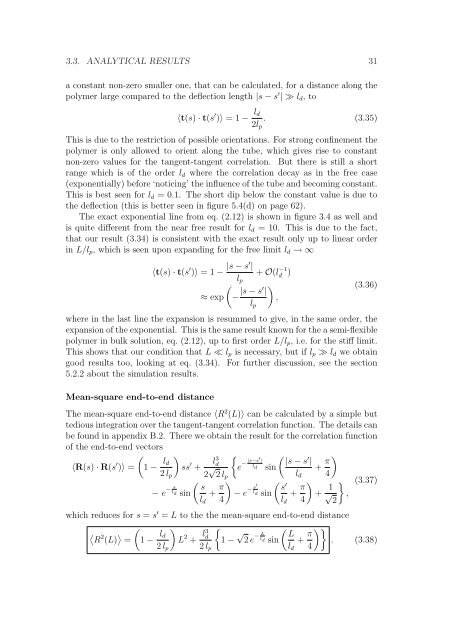Polymers in Confined Geometry.pdf
Polymers in Confined Geometry.pdf
Polymers in Confined Geometry.pdf
Create successful ePaper yourself
Turn your PDF publications into a flip-book with our unique Google optimized e-Paper software.
3.3. ANALYTICAL RESULTS 31<br />
a constant non-zero smaller one, that can be calculated, for a distance along the<br />
polymer large compared to the deflection length |s − s ′ | ≫ ld, to<br />
〈t(s) · t(s ′ )〉 = 1 − ld<br />
. (3.35)<br />
2lp<br />
This is due to the restriction of possible orientations. For strong conf<strong>in</strong>ement the<br />
polymer is only allowed to orient along the tube, which gives rise to constant<br />
non-zero values for the tangent-tangent correlation. But there is still a short<br />
range which is of the order ld where the correlation decay as <strong>in</strong> the free case<br />
(exponentially) before ‘notic<strong>in</strong>g’ the <strong>in</strong>fluence of the tube and becom<strong>in</strong>g constant.<br />
This is best seen for ld = 0.1. The short dip below the constant value is due to<br />
the deflection (this is better seen <strong>in</strong> figure 5.4(d) on page 62).<br />
The exact exponential l<strong>in</strong>e from eq. (2.12) is shown <strong>in</strong> figure 3.4 as well and<br />
is quite different from the near free result for ld = 10. This is due to the fact,<br />
that our result (3.34) is consistent with the exact result only up to l<strong>in</strong>ear order<br />
<strong>in</strong> L/lp, which is seen upon expand<strong>in</strong>g for the free limit ld → ∞<br />
〈t(s) · t(s ′ )〉 = 1 − |s − s′ |<br />
lp<br />
<br />
≈ exp − |s − s′ |<br />
lp<br />
+ O(l −1<br />
d )<br />
<br />
,<br />
(3.36)<br />
where <strong>in</strong> the last l<strong>in</strong>e the expansion is resummed to give, <strong>in</strong> the same order, the<br />
expansion of the exponential. This is the same result known for the a semi-flexible<br />
polymer <strong>in</strong> bulk solution, eq. (2.12), up to first order L/lp, i.e. for the stiff limit.<br />
This shows that our condition that L ≪ lp is necessary, but if lp ≫ ld we obta<strong>in</strong><br />
good results too, look<strong>in</strong>g at eq. (3.34). For further discussion, see the section<br />
5.2.2 about the simulation results.<br />
Mean-square end-to-end distance<br />
The mean-square end-to-end distance 〈R 2 (L)〉 can be calculated by a simple but<br />
tedious <strong>in</strong>tegration over the tangent-tangent correlation function. The details can<br />
be found <strong>in</strong> appendix B.2. There we obta<strong>in</strong> the result for the correlation function<br />
of the end-to-end vectors<br />
〈R(s) · R(s ′ )〉 =<br />
<br />
1 − ld<br />
<br />
ss<br />
2 lp<br />
′ + l3 d<br />
2 √ 2 lp<br />
s<br />
− l − e d s<strong>in</strong><br />
s<br />
ld<br />
+ π<br />
4<br />
<br />
<br />
e − |s−s′ <br />
|<br />
′ |s − s |<br />
ld s<strong>in</strong><br />
ld<br />
<br />
s′ ′<br />
− s l − e d s<strong>in</strong> +<br />
ld<br />
π<br />
4<br />
<br />
+ π<br />
<br />
4<br />
+ 1<br />
√ 2<br />
<br />
,<br />
(3.37)<br />
which reduces for s = s ′ = L to the the mean-square end-to-end distance<br />
<br />
2<br />
R (L) = 1 − ld<br />
<br />
L<br />
2 lp<br />
2 + l3 <br />
d<br />
1 −<br />
2 lp<br />
√ <br />
L<br />
− L<br />
l 2 e d s<strong>in</strong> +<br />
ld<br />
π<br />
<br />
. (3.38)<br />
4













